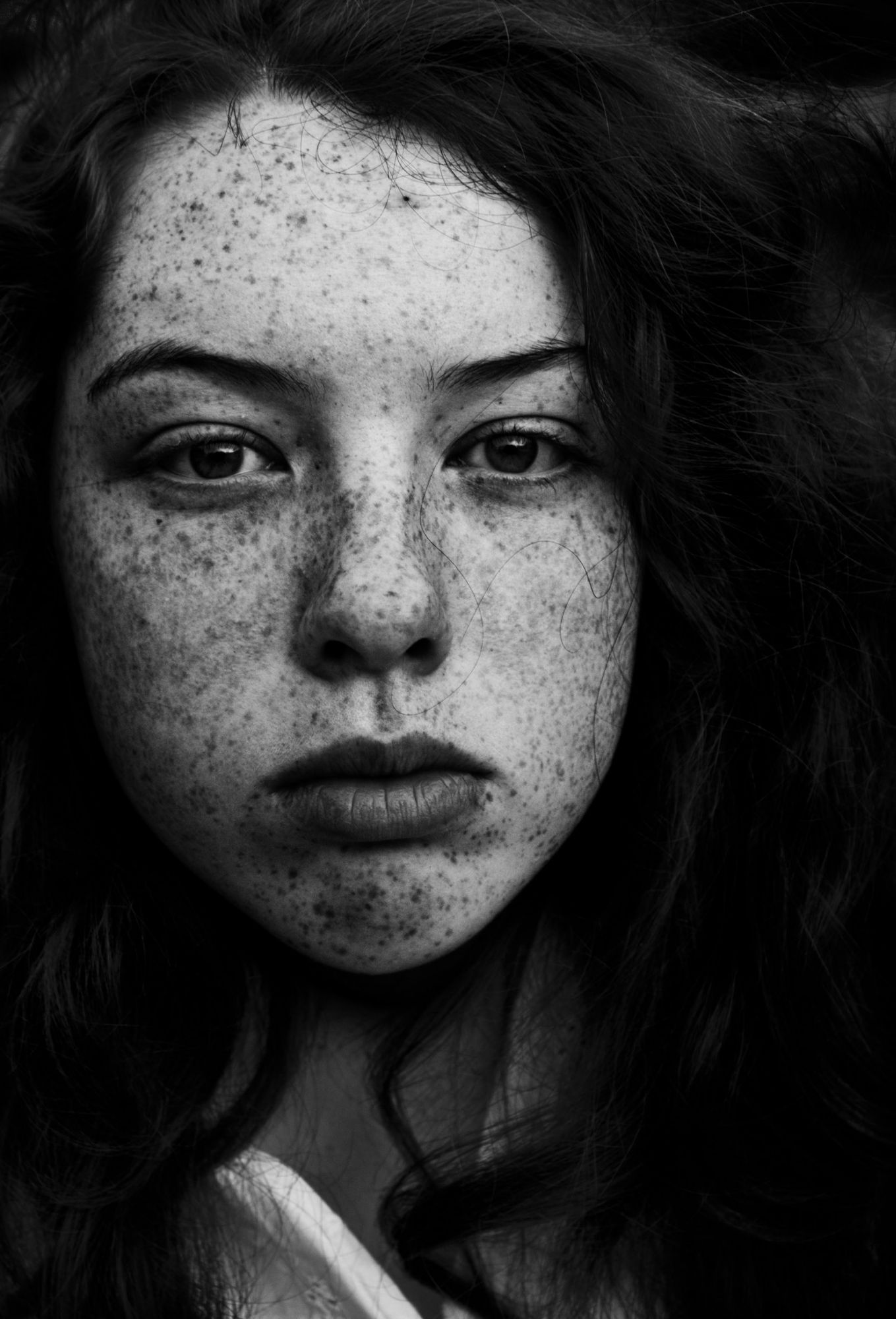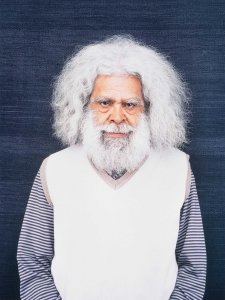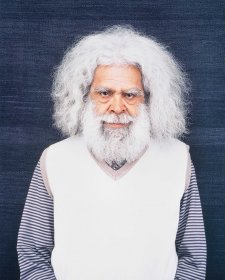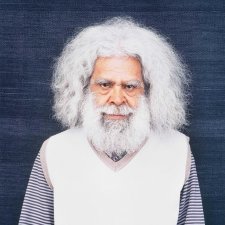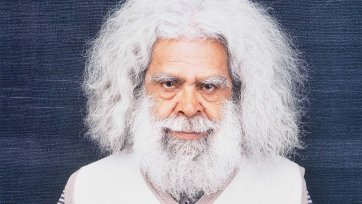Beauty comes in many different forms and is just as subjective as photography. I love my little sister's face because it is dusted with freckles. I really wanted to capture her when she forgets that I have a camera in front of her face. I wanted that moment just after a smile, when the expression reveals the authentic self. I think the magic of portraits is being able to take a photograph as if the photographer is completely absent.
Questions
1. How does the use of black and white influence your interpretation of the portrait?
2. Eden's face fills the frame of McNaught's portrait. Why do you think the photographer has chosen to compose the portrait of her sister this way?
3. How are the ideas and themes of the photographer conveyed in the portrait of Eden?
The photographer and the portrait -
an interview
How do you define your own practice?
I would probably say I am a photojournalist but I really don't know what the future holds for me yet. How I would define my practice as a photographer is that I am really passionate about capturing my subjects as authentically as possible. My personal ethics really attracted me to study photojournalism. I was in a lecture debating whether or not to study photojournalism and I was fortunate to attend Heather Faulkner's lecture that introduced photojournalism. She said something to the effect of photojournalism is all about asking questions and mainly just one and that is 'what does it mean to be human?' What I have come to learn in a very short period of time is that everyone is vastly different but there are two fundamental similarities: that everyone is important and that everyone is seeking validation in some form or other. Whenever I have the privilege to photograph anyone I always keep this in mind and try to create a relationship with the individual or, if I am on the street, I always try to observe those around me to understand human behaviour before just instantly taking a photo. Jack Picone's famous saying that he would constantly tell his students to find Henri Cartier-Bresson's decisive moment and slow down! I agree with him. What are two hundred useless shots when you could have just slowed down and thought about it and have two really great frames? That is something I really had to learn at first and am still learning to do.
What is your relationship to the subject?
In the case of the portrait it is my sister. Knowing someone so well makes it easy to select photos and photograph them. However, when I take photos of complete strangers I think it is really important to develop a rapport with people. To always go back and show a genuine interest in them. I love that about photography - it allows me to meet all kinds of people. My university lecturer taught me about the importance of contacts. She is my inspiration when it comes to having a relationship with subjects, and people in general, and will do absolutely anything to retain and gain contacts. I think she is the most courageous person I have ever met because she will approach anyone and I have seen her do this. I hope that I will become like her one day.
Was the photograph a result of a constructed or candid encounter?
The photograph was definitely a candid encounter. I was taking photos for my university assignment which was a series of constructed images so I had been shooting for about an hour and a half. I had the images I needed for my assignment but I knew Eden was getting a bit over being photographed and the light was perfect! It was a real spur of the moment. I had seen that expression on her face before. It is a habit I have got into by really noticing things around me, even when I don't have a camera and I mentally think of when I would press the shutter. I sat her down and waited for the expression I had seen. I took some frames just to get Eden comfortable with the camera and I was talking to her. I think that is the key to getting a good portrait. I can't emphasise this enough. I saw the moment and I took the photo. It was the last shot of the day. Often that happens to me where the last frame is the best because I become so focused the more I shoot and the subject becomes less aware of the camera.
What are the ideas or themes underpinning your portrait?
I guess Eden's age is the main theme that can be taken from the image. Eden was 13 at the time the photograph was shot. I think there is a brilliancy being a youth, especially the age between 11-13. I think these years are the most challenging years because everything seems to change both physically and emotionally. I think there is an innocence that is still retained but I found that those years I was searching and wondering who I would be. Eden is five years younger than I am and it is really interesting listening to her point of view of starting high school when I have just finished.
Describe the technical aspects of your photograph?
I wish I could write Canon 5D Mark II, but I can't. I shoot on a Canon 500D. I love working with natural light. Mainly ambient light is my favourite light to work with especially for portraits because it doesn't cast harsh shadows over the face. Reading light is extremely important and learning to recognise how it works and where it is. "Light makes photography. Embrace light. Admire it. Love it. But above all, know light. Know it for all you are worth, and you will know the key to photography." George Eastman When it came to the digital imaging process I used two programs: Adobe Bridge and Photoshop. I found that the printing stage was easier to evaluate, to experiment and improve the digital processing.
How was the final print made? Is this print one of an edition?
I printed my photograph at LiveImage which is affiliated with Griffith University. The print is a single edition. Printing is such a process of experimentation. I did a series of small test prints and adjusted the way I edited the photo to make sure that I preserved as much detail as possible. It is refreshing and exciting seeing a physical photo and then examining it and how to improve it rather than just staring at a computer screen. I ended up using a really high quality thick paper which is called Photo Rag Pearl. I also used an Epson inkjet printer.
Describe your consideration of scale, mounting and framing in the presentation of your portrait?
I guess my main concern was staying within the requirements of the Gallery. I really wanted to have something that was simple. I did want the photograph to be big but not too overbearing. With mounting, I wanted an off white matte because I found the pure white took away from the photograph. I guess it was like the printing process - a series of trials and errors. Also I was able to find an experienced framer that I was really fortunate to work with.
Who would you nominate as your influences?
Tamara Dean Steve McCurry; Narelle Autio; Olivia Arthur; Robert Capa; Henri Cartier; Bresson; Tracey Moffat; Trent Parke; Heather Faulkner; Jack Picone; Charles Page; Margret Waller; David Dare Parker; Helen Levitt; Matt Carr; Ruth Harriet Louise. I have so many more photographers I could list that have influenced me. I think it is really important to immerse yourself by going to exhibitions and looking at photographs of others.
Do you have any advice for a beginning photographer (eg. students)?
I guess I am a young aspiring photographer. I think my main advice is something Audrey Hepburn said "Nothing is impossible; the word itself says I'm possible." For a first year photography student that works at Foodworks, the National Photographic Portrait Prize was an impossibility. I laughed and thought there was some kind of mistake when I found out I was a finalist. If you have a dream and work really hard and have goals you will eventually gain success. Another thing that has influenced me is "Success is the ability to go from one failure to another with no loss of enthusiasm." (Sir Winston Churchill). I know there have been times where I have been disheartened and wondered if I will ever be good enough but persistence is the key. Learning something new is always challenging and photography is no exception. It seems like a deceptively easy discipline but it really takes time to refine and master. Education is essential and I am endeavouring to absorb everything I can while I am studying. However, any form of education or experience is never wasted so seek opportunities that will develop you as a photographer.
